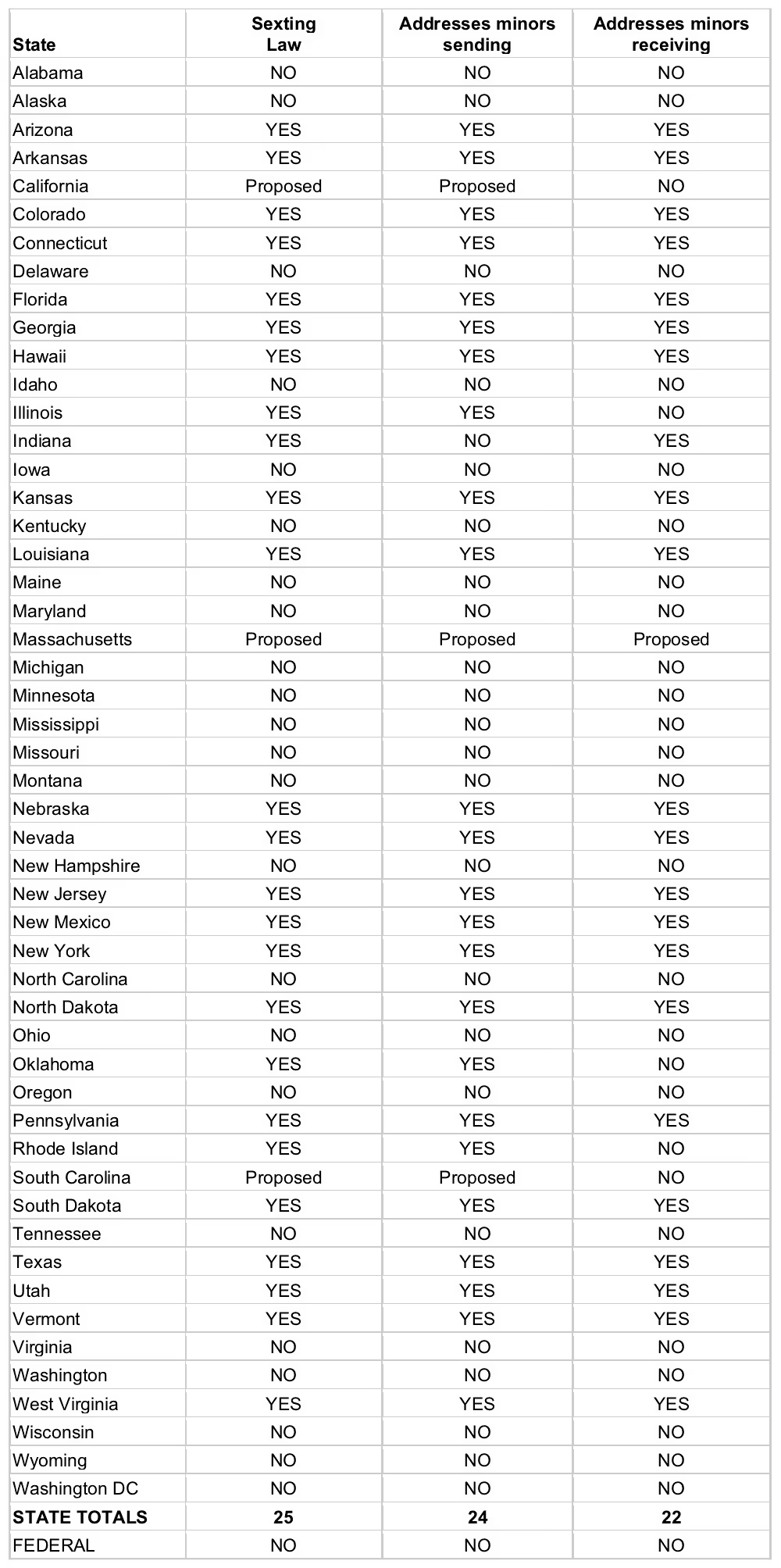


Teenagers are budding with sexual energy. Mix that with cell phones and it can be a complicated combination. According to a JAMA Pediatrics report from last April that analyzed 39 studies of just over 110,000 under 18-year-olds (the mean age was 15.16 years, but ages ranged from 11-17 years)— it was found that roughly 15% of teenagers send sexts and 28% receive them.
It is so important to have an open line of communication with preteens and teens about the issues around revealing photos and videos (yes, videos—some teens send short sexually explicit videos to one another). Today’s TTT is all about just the facts. In a pragmatic way, try sharing with your teens and preteens what the laws are in your state—and, starting with this example case can also be helpful.
In 2015, two 16-year-olds from North Carolina were arrested and charged with multiple felony counts of sexual exploitation of a minor under the state’s child pornography laws. Their crime? The boyfriend and girlfriend sent nude photos to each other via text. They were charged as adults, faced four to ten years in prison and would have to register as sex offenders if convicted. The kids agreed to plea bargains that reduced their charges to misdemeanors. Still, a very scary situation. The teens were doing what some sexually curious boyfriends and girlfriends do—the last thing they wanted was to get in trouble and to break a law.
North Carolina does not have any sexting laws—in fact, half of states do not have sexting laws. If the couple had been in a state with sexting laws, such as Arizona, Florida or Arkansas, they would have most likely been charged with something such as a misdemeanor and given the chance to prove their intent was not criminal. Sexting legislation is designed to deter teens from sexting with consequences including education and less severe sentences.

We would love for you to share this TTT any way that works for you, whether that’s on social media or via a newsletter. If you want to send it out in your newsletter we just ask that you credit us and link to our website, and let us know at lisa@screenagersmovie.com.
HOST A SCREENING to help spark change.
FIND EVENT LISTINGS
Do you organize professional development in schools? We now have a 6-hour, 3-part training module. Request more information here Professional Development.
Stay in touch with the Screenagers community on Facebook, Twitter and leave comments below.
Learn more about showing our movies in your school or community!
Join Screenagers filmmaker Delaney Ruston MD for our latest Podcast

Learn more about our Screen-Free Sleep campaign at the website!
Our movie made for parents and educators of younger kids
Learn more about showing our movies in your school or community!
Learn more about showing our movies in your school or community!
Join Screenagers filmmaker Delaney Ruston MD for our latest Podcast

Learn more about our Screen-Free Sleep campaign at the website!
Our movie made for parents and educators of younger kids
Join Screenagers filmmaker Delaney Ruston MD for our latest Podcast
As we’re about to celebrate 10 years of Screenagers, we want to hear what’s been most helpful and what you’d like to see next.
Please click here to share your thoughts with us in our community survey. It only takes 5–10 minutes, and everyone who completes it will be entered to win one of five $50 Amazon vouchers.
Teenagers are budding with sexual energy. Mix that with cell phones and it can be a complicated combination. According to a JAMA Pediatrics report from last April that analyzed 39 studies of just over 110,000 under 18-year-olds (the mean age was 15.16 years, but ages ranged from 11-17 years)— it was found that roughly 15% of teenagers send sexts and 28% receive them.
It is so important to have an open line of communication with preteens and teens about the issues around revealing photos and videos (yes, videos—some teens send short sexually explicit videos to one another). Today’s TTT is all about just the facts. In a pragmatic way, try sharing with your teens and preteens what the laws are in your state—and, starting with this example case can also be helpful.
In 2015, two 16-year-olds from North Carolina were arrested and charged with multiple felony counts of sexual exploitation of a minor under the state’s child pornography laws. Their crime? The boyfriend and girlfriend sent nude photos to each other via text. They were charged as adults, faced four to ten years in prison and would have to register as sex offenders if convicted. The kids agreed to plea bargains that reduced their charges to misdemeanors. Still, a very scary situation. The teens were doing what some sexually curious boyfriends and girlfriends do—the last thing they wanted was to get in trouble and to break a law.
North Carolina does not have any sexting laws—in fact, half of states do not have sexting laws. If the couple had been in a state with sexting laws, such as Arizona, Florida or Arkansas, they would have most likely been charged with something such as a misdemeanor and given the chance to prove their intent was not criminal. Sexting legislation is designed to deter teens from sexting with consequences including education and less severe sentences.

We would love for you to share this TTT any way that works for you, whether that’s on social media or via a newsletter. If you want to send it out in your newsletter we just ask that you credit us and link to our website, and let us know at lisa@screenagersmovie.com.
HOST A SCREENING to help spark change.
FIND EVENT LISTINGS
Do you organize professional development in schools? We now have a 6-hour, 3-part training module. Request more information here Professional Development.
Stay in touch with the Screenagers community on Facebook, Twitter and leave comments below.
Sign up here to receive the weekly Tech Talk Tuesdays newsletter from Screenagers filmmaker Delaney Ruston MD.
We respect your privacy.
Teenagers are budding with sexual energy. Mix that with cell phones and it can be a complicated combination. According to a JAMA Pediatrics report from last April that analyzed 39 studies of just over 110,000 under 18-year-olds (the mean age was 15.16 years, but ages ranged from 11-17 years)— it was found that roughly 15% of teenagers send sexts and 28% receive them.
It is so important to have an open line of communication with preteens and teens about the issues around revealing photos and videos (yes, videos—some teens send short sexually explicit videos to one another). Today’s TTT is all about just the facts. In a pragmatic way, try sharing with your teens and preteens what the laws are in your state—and, starting with this example case can also be helpful.
In 2015, two 16-year-olds from North Carolina were arrested and charged with multiple felony counts of sexual exploitation of a minor under the state’s child pornography laws. Their crime? The boyfriend and girlfriend sent nude photos to each other via text. They were charged as adults, faced four to ten years in prison and would have to register as sex offenders if convicted. The kids agreed to plea bargains that reduced their charges to misdemeanors. Still, a very scary situation. The teens were doing what some sexually curious boyfriends and girlfriends do—the last thing they wanted was to get in trouble and to break a law.
North Carolina does not have any sexting laws—in fact, half of states do not have sexting laws. If the couple had been in a state with sexting laws, such as Arizona, Florida or Arkansas, they would have most likely been charged with something such as a misdemeanor and given the chance to prove their intent was not criminal. Sexting legislation is designed to deter teens from sexting with consequences including education and less severe sentences.

We would love for you to share this TTT any way that works for you, whether that’s on social media or via a newsletter. If you want to send it out in your newsletter we just ask that you credit us and link to our website, and let us know at lisa@screenagersmovie.com.
HOST A SCREENING to help spark change.
FIND EVENT LISTINGS
Do you organize professional development in schools? We now have a 6-hour, 3-part training module. Request more information here Professional Development.
Stay in touch with the Screenagers community on Facebook, Twitter and leave comments below.

So what is pornography, and how do we talk with our young people about this prickly topic? Every time I sit down to write about this, I feel a bit of sadness and, frankly, disbelief. It’s hard to accept that we’ve created a society where youth can be just a click away from all sorts of highly explicit sexual material. And yes, parental controls and blockers can help, but the internet is everywhere, and chances are, they will see things somewhere. But we have to talk about it.
READ MORE >
In today's blog I introduce and give a brief summary of my recent podcast conversation with Jo-Ann Finkelstein, PhD, psychologist and author of Sexism and Sensibility, where we spoke about many topics such as how to raise girls with fierce ambition and critical awareness of gender inequality without making them feel disheartened? And how we can help boys understand the hidden costs of rigid masculinity without shaming them into silence?
READ MORE >
A parent recently told me how upset she was because her teen’s sports team posted something inappropriate in their social media group. Today I share my advice to the mom about ways to handle such a situation.
READ MORE >for more like this, DR. DELANEY RUSTON'S NEW BOOK, PARENTING IN THE SCREEN AGE, IS THE DEFINITIVE GUIDE FOR TODAY’S PARENTS. WITH INSIGHTS ON SCREEN TIME FROM RESEARCHERS, INPUT FROM KIDS & TEENS, THIS BOOK IS PACKED WITH SOLUTIONS FOR HOW TO START AND SUSTAIN PRODUCTIVE FAMILY TALKS ABOUT TECHNOLOGY AND IT’S IMPACT ON OUR MENTAL WELLBEING.
